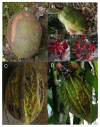Bioactive Compounds, Antioxidant, and Antimicrobial Activity of Seeds and Mucilage of Non-Traditional Cocoas
- PMID: 40227260
- PMCID: PMC11939332
- DOI: 10.3390/antiox14030299
Bioactive Compounds, Antioxidant, and Antimicrobial Activity of Seeds and Mucilage of Non-Traditional Cocoas
Abstract
The biodiversity of the Amazon rainforest includes little-known cocoa species, which are essential resources for local communities. This study evaluated the bioactive compounds and antioxidant and antimicrobial activity of seeds and mucilage of four non-traditional cocoa species (Theobroma subincanum, T. speciosum, T. bicolor and Herrania nitida). Physico-chemical properties, minerals, vitamin C, organic acids, phenolics, and carotenoids were analysed by spectrophotometric and chromatographic techniques. The antioxidant activity was measured by ABTS and DPPH, along with the antimicrobial activity against Escherichia coli, Staphylococcus aureus, Pseudomonas aeruginosa, and Streptococcus mutans, as well as Candida albicans and Candida tropicalis. T. subincanum seeds scored high in titratable acidity, magnesium, sodium, syringic acid, chlorogenic acid, caffeic acid, rutin, and quercetin. In contrast, the mucilage scored high in calcium, m-coumaric acid, ferulic acid, kaempferol, quercetin glycoside, and antimicrobial activity against Streptococcus mutans. T. speciosum mucilage excelled in malic acid, tartaric acid, naringenin, and antioxidant capacity. T. bicolor seeds excelled in lutein and antimicrobial activity against Staphylococcus aureus and Candida albicans, and mucilage in iron, potassium, vitamin C, citric acid, gallic acid and 4-hydroxybenzoic acid, zeaxanthin, β-carotene, and antioxidant capacity by ABTS. The mucilage of H. nitida has a high soluble solids content. These results highlight the potential of these species as sustainable sources of functional compounds and nutraceuticals.
Keywords: Amazon rainforest; carotenoids; in vitro; microextraction; organic acid; phenols.
Conflict of interest statement
The authors declare no conflicts of interest. The Ecuadorian Corporation for the Development of Research and the Academy (CEDIA) had no role in the design of the study; in the collection, analysis, or interpretation of the data; in the writing of the manuscript; or in the decision to publish the article.
Figures




Similar articles
-
Functional, Antioxidant, Antibacterial, and Antifungal Activity of Edible Flowers.Antioxidants (Basel). 2024 Oct 25;13(11):1297. doi: 10.3390/antiox13111297. Antioxidants (Basel). 2024. PMID: 39594439 Free PMC article.
-
Bioactive Composition of Tropical Flowers and Their Antioxidant and Antimicrobial Properties.Foods. 2024 Nov 24;13(23):3766. doi: 10.3390/foods13233766. Foods. 2024. PMID: 39682838 Free PMC article.
-
Study of chemical constituents, antioxidants and antimicrobial activities of Tamarindus indica L. seed.J Food Sci. 2023 Nov;88(11):4639-4652. doi: 10.1111/1750-3841.16739. Epub 2023 Sep 27. J Food Sci. 2023. PMID: 37755709
-
Antioxidant and antimicrobial activities, and phenolic compounds of selected Inula species from Turkey.Nat Prod Commun. 2013 Apr;8(4):475-8. Nat Prod Commun. 2013. PMID: 23738457
-
Green Extraction of Bioactive Compounds from Plant Biomass and Their Application in Meat as Natural Antioxidant.Antioxidants (Basel). 2021 Sep 15;10(9):1465. doi: 10.3390/antiox10091465. Antioxidants (Basel). 2021. PMID: 34573097 Free PMC article. Review.
Cited by
-
Phytochemical Composition and Biological Properties of Macleania rupestris Fruit Extract: Insights into Its Antimicrobial and Antioxidant Activity.Antioxidants (Basel). 2025 Mar 27;14(4):394. doi: 10.3390/antiox14040394. Antioxidants (Basel). 2025. PMID: 40298645 Free PMC article.
References
-
- POWO Theobroma L. [(accessed on 21 October 2024)]. Available online: https://powo.science.kew.org/taxon/urn:lsid:ipni.org:names:30005713-2.
-
- Moreira J., Queiroz E., Frota R., Campelo P., Sanches E., De Araújo J. Theobroma spp.: A Review of It’s Chemical and Innovation Potential for the Food Industry. Food Chem. Adv. 2024;4:100683. doi: 10.1016/J.FOCHA.2024.100683. - DOI
-
- Lanaud C., Vignes H., Utge J., Valette G., Rhoné B., Mariella G., Angarita N., Fouet O., Gaikwad N., Zarrillo S., et al. A Revisited History of Cacao Domestication in Pre-Columbian Times Revealed by Archaeogenomic Approaches. Sci. Rep. 2024;14:2972. doi: 10.1038/s41598-024-53010-6. - DOI - PMC - PubMed
-
- Sitarek P., Merecz-Sadowska A., Sikora J., Osicka W., Śpiewak I., Picot L., Kowalczyk T. Exploring the Therapeutic Potential of Theobroma cacao L.: Insights from in Vitro, in Vivo, and Nanoparticle Studies on Anti-Inflammatory and Anticancer Effects. Antioxidants. 2024;13:1376. doi: 10.3390/antiox13111376. - DOI - PMC - PubMed
-
- Singh M., Agarwal S., Agarwal M. Plant-Derived Bioactives. Springer; Singapore: 2020. Rachana Benefits of Theobroma cacao and Its Phytocompounds as Cosmeceuticals; pp. 509–521. - DOI
LinkOut - more resources
Full Text Sources

